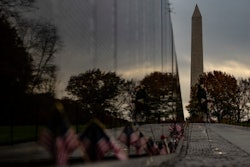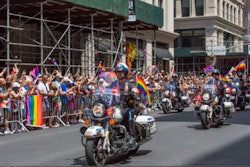 Mount Rainier is the tallest volcanic mountain in the contiguous United States, and due to the ever-increasing prospect of an eruption, it is considered one of the most dangerous volcanoes on the planet. Reaching its summit—and getting back down—is an appropriate metaphor for policing in America at the midway point of 2021. (Image courtesy of June Burton Wilson / Facebook)
Mount Rainier is the tallest volcanic mountain in the contiguous United States, and due to the ever-increasing prospect of an eruption, it is considered one of the most dangerous volcanoes on the planet. Reaching its summit—and getting back down—is an appropriate metaphor for policing in America at the midway point of 2021. (Image courtesy of June Burton Wilson / Facebook)
Earlier this week, we reported that the Oakland (CA) City Council approved a budget that will strip $18 million in funding from that troubled city's police department. The elected officials on that body voted 7-2 in favor of a proposal to redirect the funds from the police department to the Department of Violence Prevention with the intention of improving public safety.
Oakland Police Chief LeRonne Armstrong lamented that the decision to further defund his department would prevent his officers from adequately completing even day-to-day tasks like traffic enforcement and responding to emergency calls.
Oakland is just one of nearly two dozen cities across America to have pulled funding from their police. Cities such as Austin, Baltimore, Los Angeles, Milwaukee, Minneapolis, New York, Philadelphia, Seattle, and others have shifted funds from police departments to social services programs. These cuts have led to some pretty terrible consequences.
Defunding the police—and the awful toll such actions have taken on cities across America—is just one of several unfortunate trends we've witnessed in the past several months.
As we've reached the halfway point in the year 2021, it's a useful enterprise to examine events impacting law enforcement that have transpired in the past six months what meaning we may glean from them for what lies ahead.
A Mighty Mountain
To say that it's been an "uphill slog" for police so far in 2021 is an understatement of monumental magnitude. While anti-police politicians vote to "reallocate" money from law enforcement to other "social programs" anti-police sentiment has led to a rise in violent crime in many places.
The murder rates in major American cities—many of which have been "defunded"—has jumped.
In Philadelphia, the murder rate is up 40% over last year, in Minneapolis the rise is 56%, and in Portland (OR)—where anti-police "protesters" set up a fenced-off, booby-trapped "autonomous zone" in 2020, the homicide rate has increased by a whopping 800%.
Video of violent assaults in broad daylight by deranged homeless people on ordinary citizens are so commonplace on social media that such events rarely even make the news anymore.
Instead, local and national news media air footage of innocent people being gunned down in places like New York's once-glamorous Times Square or Chicago's persistently notorious South Side.
Property crimes are also on the rise. In San Francisco, shoplifting and looting has become so rampant that Walgreens has closed and boarded up 17 of its stores. The City by the Bay has also seen a spike in residential burglaries dramatically rising by about 78%.
It is the police—regardless of having had their capabilities hamstrung by the defunding movement—who are charged with the unenviable task of responding to the lawlessness, placing themselves at heightened risk of death or great bodily harm.
Indeed, as of this writing, 159 police officers have died in the line of duty in the United States. The vast majority—75 officers—have died from COVID-19. The second leading cause of death is gunfire with 28 killed this way. Thirteen others have been murdered by vehicular assault and 10 have been fatally struck by a vehicle.
Countless others have been seriously injured in the line of duty—assaulted with edged weapons, blunt instruments, and all manner of improvised attacks.
Tragically, 69 officers have been confirmed by Blue H.E.L.P.—a 501(c)3 that tracks and reports on officer suicide—to have died by their own hand thus far in 2021.
The loss of those lives claimed by suicide cannot be adequately counted—the impact of those deaths touches every family member, every friend, and every fellow officer in profound ways.
Defunding, De-Policing, and Destabilizing
Defunding the police is inextricably linked to de-policing—the withdrawal of police from the process of protecting and serving American citizens.
In some cities, the practice of proactive policing is in danger of becoming lost to history. As has been noted, the plague of violent crime in those cities is spreading like... well, it's spreading like the plague.
American citizens—particularly those whom the "defund the police" movement are so keen to claim to be protecting from the big, bad, boys and girls in blue—are suffering. Gun battles between rival gang bangers claim the lives of innocent men, women, and children who simply want to live in peace.
Defunding the police—and the subsequent de-policing of crime-ridden cities and towns—leads inevitably to a destabilizing of American society overall.
This is not something police in this country are doing to American citizens. Citizens have voted en masse to place anti-police politicians into seats of power where they speak of "dismantling" and "reimagining" policing. This rhetoric has had the consequence of creating "neighborhoods closely resembling a combination of scenes from the movies "Mad Max" and "The Purge"—as I have so frequently written it would.
Obvious questions arise. Can these terrible trends we've seen so far in 2021 be reversed? If so, how?
Who will lead the effort?
Who will follow?
I have a friend from high school who—as I write this column—is standing at 14,411 feet above sea level on the summit of Mount Rainier after completing his climb up the treacherous slope.
He's made it to the top. He's reached the zenith. His ascent is complete.
But he's only halfway home.
Every step he's taken thus far must be replicated in reverse in a phase of his expedition that practically any climber will tell you is more dangerous than the ascent.
This is the metaphor I see for American law enforcement today.
In mountain climbing, getting to the summit is optional—getting safely back home is essential.
Sound familiar?
The year 2021 to this point has been an uphill slog for police, and there is much more work to be done before we turn the calendar to 2022.
So, as we pass the benchmark denoting the mid-way point of a year that has been tumultuous for police officers across the country, I wish you all safe passage through whatever lies before you.
















